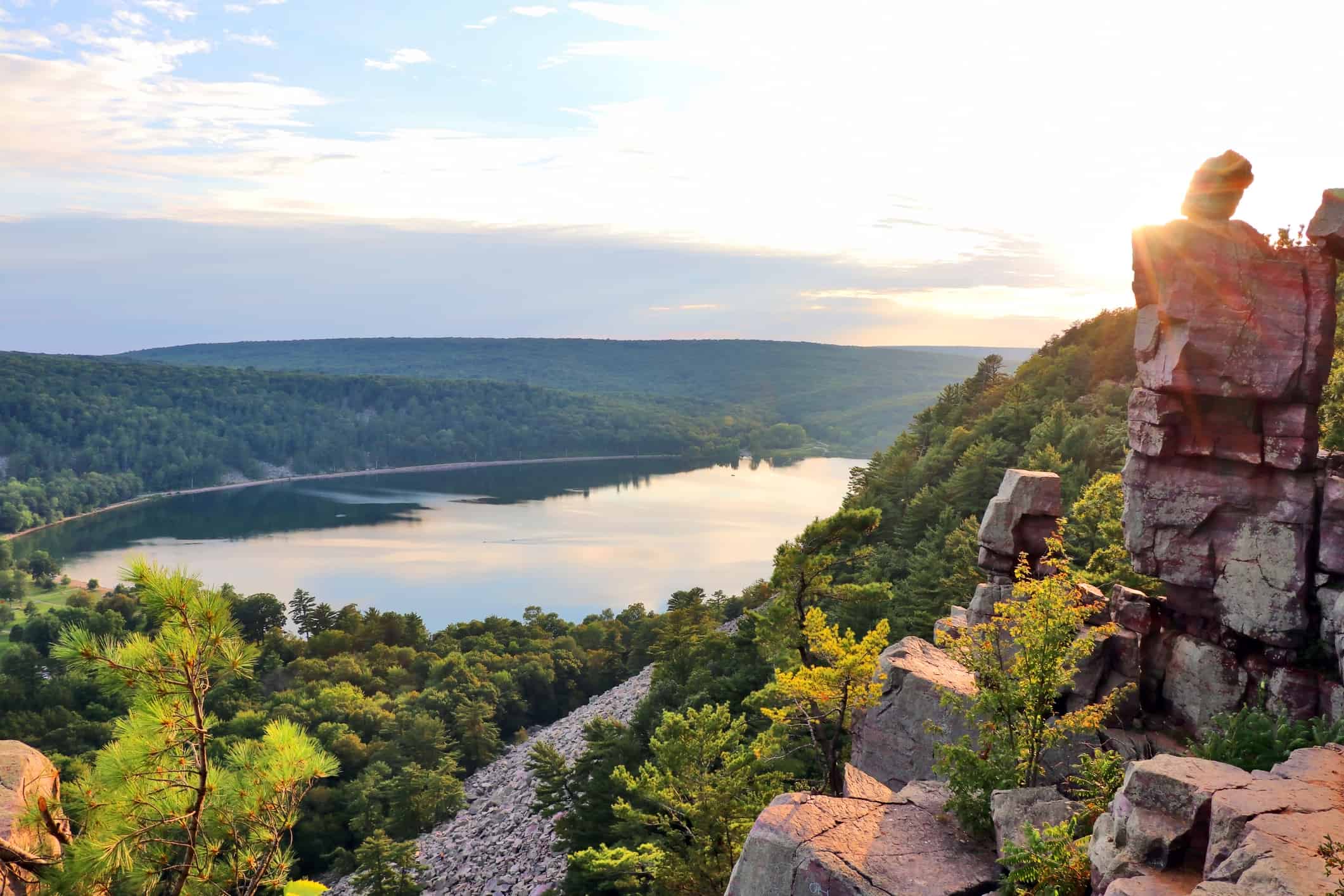The Wisconsin Ice Age Trail is a stunning long-distance hiking trail that spans approximately 1,200 miles and winds through some of Wisconsin’s most beautiful landscapes. Hikers can encounter several lakes along this trail, each with a unique charm.
What Is the Wisconsin’s Ice Age Trail?
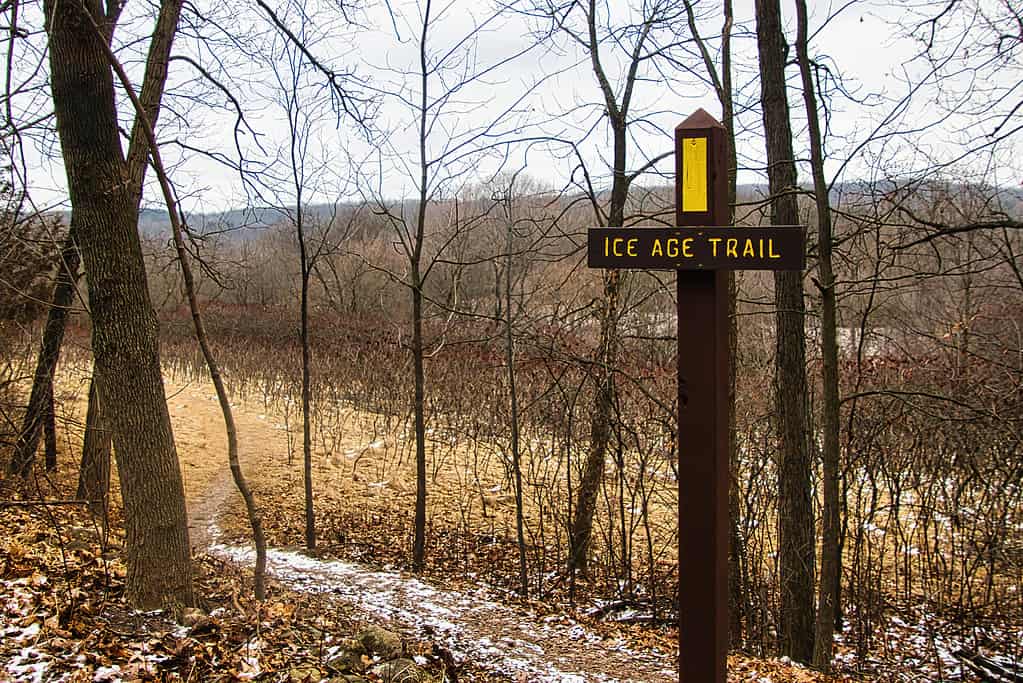
The Ice Age Trail can take two to three months to finish.
©Dave Jonasen/iStock via Getty Images
The Wisconsin Ice Age Trail is a long-distance hiking trail that stretches approximately 1,200 miles (1,931 kilometers) across Wisconsin. Established as a tribute to the state’s unique geological history, the trail showcases the legacy of the last Ice Age.
The history of the Wisconsin Ice Age Trail dates back to the mid-20th century. Ray Zillmer, a Milwaukee attorney and avid hiker, envisioned a footpath that would trace the glacial formations in the state. His passion for preserving the region’s natural beauty and geological significance led to the establishment of the Ice Age Park and Trail Foundation in 1958. Over time, his efforts attracted volunteers, advocates, and conservationists dedicated to creating and maintaining the trail.
In 1980, after decades of planning and dedication, the Wisconsin State Legislature officially designated the Ice Age Trail as a State Scenic Trail. The trail’s development continued through the work of numerous volunteers, trail enthusiasts, and government agencies. Today, it stands as one of only 11 National Scenic Trails in the United States.
The Ice Age Trail starts at the Interstate State Park on the St. Croix National Scenic Riverway in northwestern Wisconsin and crosses the entire state, ending at Sturgeon City on the shores of Green Bay, Lake Michigan. More than 100 people have hiked the entire Ice Age Trail. However, approximately 2.3 million use it yearly for smaller hikes, cross-country skiing, or snowmobiling.
1. Lake Michigan

Lake Michigan is the second-largest lake by volume area and third-largest by surface area.
©Bo Shen/iStock via Getty Images
The Ice Age Trail ends next to one of the most famous lakes in America, Lake Michigan. This impressive body of water is the third largest of the Great Lakes by surface area. It is the only one located entirely within the United States and extends from Illinois and Indiana to Michigan and Wisconsin.
The lake is part of the Ice Age Trail in the towns of Manitowoc and two rivers as the trail follows the lake. The trail then goes back inland and reemerges on Green Bay (an arm of Lake Michigan) in Sturgeon Bay.
Scenic Beauty
The scenic beauty around Lake Michigan is nothing short of breathtaking. The landscapes are diverse and stunning, from the rugged cliffs and sand dunes along the lake’s eastern shore to the tranquil bays and wetlands of Green Bay’s western coast.
Sunsets over Lake Michigan are renowned for their vivid colors and reflect off the water’s surface, creating perfect moments. In the fall, the surrounding forests burst into a red, orange, and gold riot as the leaves change color.
Hiking
Hiking around Lake Michigan offers outdoor enthusiasts a chance to explore diverse landscapes, from pristine shorelines to lush forests and rolling dunes. The lake is home to the final stretch of the famous Wisconsin’s Ice Age Trail. But it also offers dozens of other trails perfect for hikers.
One popular hiking destination along Lake Michigan is the Lakeshore Trail within Indiana Dunes National Park. This picturesque trail extends for about 15 miles along the southern shore of Lake Michigan and takes hikers through diverse ecosystems, including sandy beaches, wetlands, and dense woodlands. The park also boasts shorter, family-friendly trails like the West Beach Trail and the Cowles Bog Trail.
Additionally, the Lakefront Trail stretches along Lake Michigan’s shoreline in Chicago, providing urban hikers with scenic views of the lake, parks, and the city’s iconic skyline.
Recreation
Lake Michigan offers numerous recreational activities such as boating, sailing, swimming, and beachcombing. The shoreline is dotted with picturesque beaches and coastal towns that attract tourists during the summer months. Chicago, one of the largest cities in the United States, is located on the southwestern shore of Lake Michigan.
Wildlife
The Lake Michigan and Green Bay areas are teeming with diverse wildlife. The surrounding forests, wetlands, and shoreline habitats provide homes for various species. Birdwatchers will be delighted by the opportunity to spot migratory birds, such as warblers and waterfowl, along the lake’s shores and in the wetlands.
Bald eagles can often be seen soaring overhead, and the lakes support a variety of fish species, which attract anglers. In the surrounding woodlands, deer, foxes, and even the elusive bobcat may be encountered. The ecosystems around Lake Michigan offer endless opportunities for wildlife enthusiasts to observe and appreciate the natural world.
Camping
Camping in Lake Michigan is a fantastic way to immerse oneself in the beauty of the outdoors. Campgrounds are scattered along the shoreline, allowing campers to fall asleep to the sound of lapping waves. Whether you prefer tent camping, RV camping, or cabin accommodations, there are options to suit every style.
Some campgrounds are situated within state parks, providing convenient access to hiking trails, fishing spots, and nature programs. Camping under the starry skies beside the Great Lakes is an unforgettable experience for families and outdoor enthusiasts.
Shipwrecks
Lake Michigan has a fascinating maritime history known for its numerous shipwrecks. Some of these shipwrecks are accessible to divers, providing a unique opportunity to explore underwater history.
2. Devil’s Lake
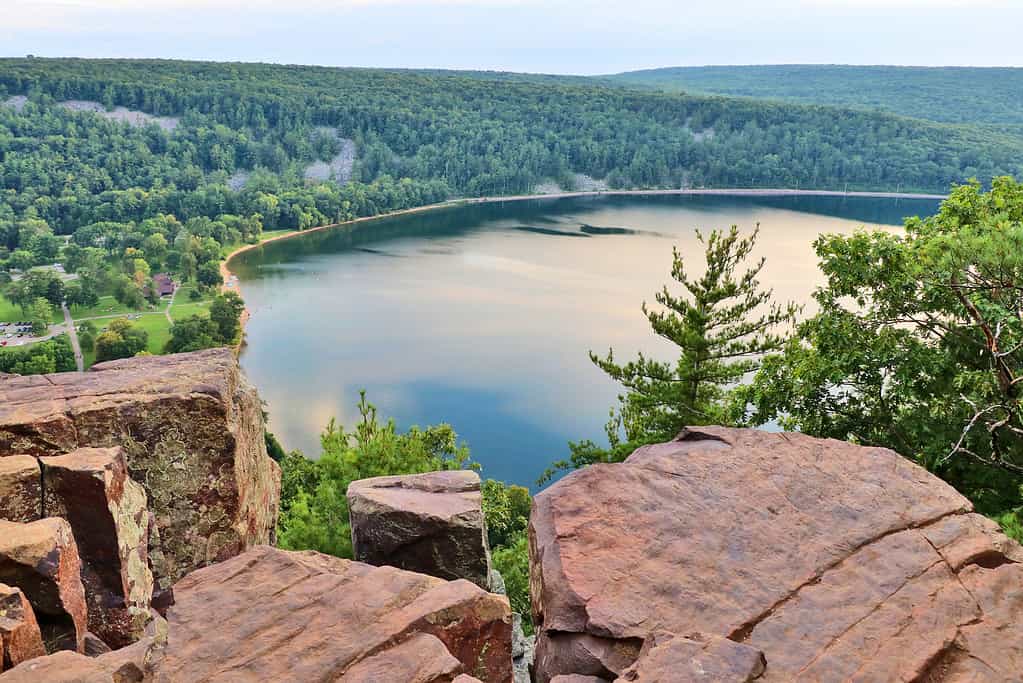
Hikers of the Ice Age Trail can admire Devil’s Lake from above.
©UWMadison/iStock via Getty Images
Devil’s Lake is one of Wisconsin’s most popular and iconic natural landmarks. It is known for its stunning beauty and outdoor recreational opportunities. This freshwater lake is located in Devil’s Lake State Park, in the Baraboo Range, a portion of Wisconsin’s Driftless Area. It was formed due to glacial activity during the last Ice Age, approximately 12,000 years ago. Glacial deposits and meltwater created a basin that eventually filled with water.
Ice Age Trail hikers will travel for 11 miles through Devil’s Lake State, giving them opportunities to admire the lake’s beauty.
Scenic Beauty
Devil’s Lake is renowned for its crystal-clear waters. The lake is relatively deep, with a maximum depth of about 47 feet, and its clarity allows you to see the submerged rock formations and aquatic life below the surface.
The lake is nestled between towering quartzite bluffs and surrounded by lush forests. These bluffs, some of which reach over 500 feet (152 meters) in height, create a dramatic backdrop and offer spectacular views of the lake.
Hiking
Hiking at Devil’s Lake State Park is a popular activity, and the park offers a variety of trails that cater to hikers of all skill levels. The park has a network of approximately 29 miles of hiking trails that wind through the park’s diverse landscapes. These trails offer a mix of terrain, from rocky bluffs to forested paths and scenic lakefront routes. They all offer panoramic views of the lake and its surroundings, especially during the fall foliage.
Outside the Ice Age Trail, hikers can also try multiple other trails offering scenic views.
- Tumbled Rocks Trail: This easy, paved trail offers a leisurely stroll along the lake’s shoreline and is accessible to all. It’s an excellent option for families and those with limited mobility.
- East Bluff Trail and West Bluff Trail: These moderately strenuous trails lead to the summits of the east and west bluffs, respectively. The climb can be steep and rocky in places, but the reward is incredible panoramic views of the lake and surrounding landscape.
- Potholes Trail: A short but moderately challenging trail that takes you to a series of unique geologic formations known as glacial potholes.
- Devil’s Doorway Trail: A moderately complex trail leading to a famous rock formation called Devil’s Doorway, with excellent views.
Recreation
Devil’s Lake State Park is a haven for outdoor enthusiasts. Hikers can explore over 29 miles of hiking trails, which offer various levels of difficulty and breathtaking lake vistas and surrounding landscapes. There are also opportunities for rock climbing along the quartzite bluffs, fishing, swimming, and picnicking.
Wildlife
Devil’s Lake State Park is teeming with diverse wildlife. The park’s lush forests and rocky bluffs provide a habitat for white-tailed deer, wild turkeys, and red foxes. Birdwatchers are also in for a treat, with opportunities to observe bald eagles, ospreys, and a variety of songbirds.
The clear waters of Devil’s Lake host aquatic life, including fish such as bass, trout, and panfish, making it a popular destination for anglers. Overall, the park’s rich biodiversity offers a harmonious blend of terrestrial and aquatic ecosystems.
Camping
Devil’s Lake State Park offers several campgrounds for those looking to spend the night there. It’s a great way to experience the area’s natural beauty up close.
Cultural Significance
Devil’s Lake has cultural significance for Native American tribes, particularly the Ho-Chunk Nation. It’s considered a sacred place, and evidence of Native American habitation dates back thousands of years. The Ho-Chunk name for the lake is “Ta-wah-cun-chunk,” meaning “Sacred Lake.”
Seasonal Changes
Devil’s Lake is a year-round hiking destination. Some trails are also used for cross-country skiing and snowshoeing in the winter. Check trail conditions and park hours before visiting during the colder months.
Due to its popularity, Devil’s Lake can get crowded, especially during weekends and holidays. If you plan to visit, consider arriving early or visiting during the quieter seasons to appreciate its beauty and tranquility fully.
3. Lake Wisconsin
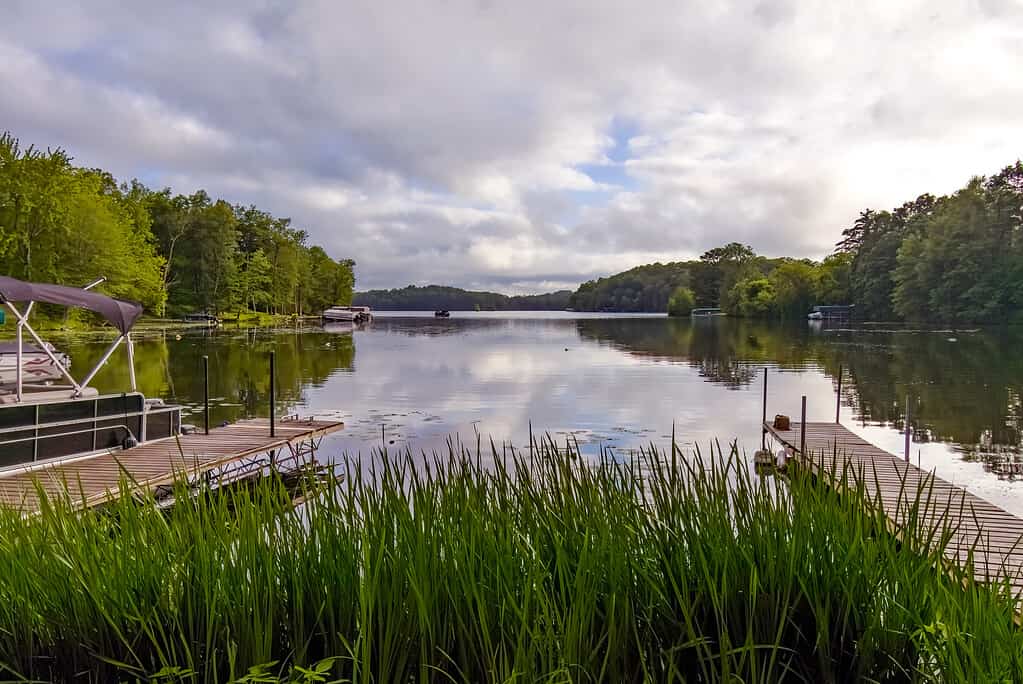
The lake exists thanks to Prairie du Sac, a hydroelectric dam.
©Jen Tepp/iStock via Getty Images
Lake Wisconsin is a beautiful reservoir in south-central Wisconsin, primarily formed by the Wisconsin River and the damming of the river’s flow. It is sometimes referred to as the “Wisconsin River Flowage.” Lake Wisconsin is a mandatory passage for the Ice Age Trail hikers as they need to cross the lake to continue the trail. They can get the ferry between the towns of Merrimac and Lodi.
Scenic Beauty
With its 9,000 acres, the lake is surrounded by picturesque bluffs and rolling hills, creating a stunning natural backdrop for outdoor enthusiasts. Lake Wisconsin also displays spectacular rock formations along its shores called the Dells. When Glacial Lake Wisconsin drained, the torrent carved the Dells.
Hiking
With a shoreline that extends for over 50 miles, Lake Wisconsin is home to lush forests, rolling hills, and charming communities. The Ice Age Trail passes through the Lake Wisconsin area, allowing hikers to explore segments of this renowned long-distance trail. The Ice Age Trail showcases glacial formations, diverse ecosystems, and picturesque lakeside views.
One famous hiking destination in the area is Gibraltar Rock State Natural Area, which offers a relatively short but rewarding trail leading to an impressive rock outcrop. From the summit, hikers can enjoy the panoramic views of Lake Wisconsin and the surrounding countryside. It’s an ideal spot for a sunrise hike or a peaceful afternoon excursion.
Recreation
Lake Wisconsin is a popular destination for outdoor recreational activities, including boating, fishing, water skiing, and swimming during the warmer months. Many marinas, boat launches, and rentals are available to visitors.
It offers excellent fishing opportunities, with species like walleye, northern pike, smallmouth bass, and catfish among the catches. In the winter, the lake is a resident’s favorite spot for ice fishing and snowmobiling.
Wildlife
Lake Wisconsin’s abundant aquatic ecosystem teems with diverse wildlife. As the sun dances on the lake’s surface, bald eagles gracefully soar above, scanning the waters for their next meal. White-tailed deer emerge to drink from the tranquil shoreline along the wooded shores while secretive raccoons and beavers craft their homes among the reeds.
Below the surface, fish like walleye, northern pike, and catfish live in the clear waters, pursued by the occasional muskie — a prized catch for anglers. Frogs and turtles bask in the sun along the banks, and migratory waterfowl, including ducks and geese, make seasonal pitstops at Lake Wisconsin.
4. Long Lake
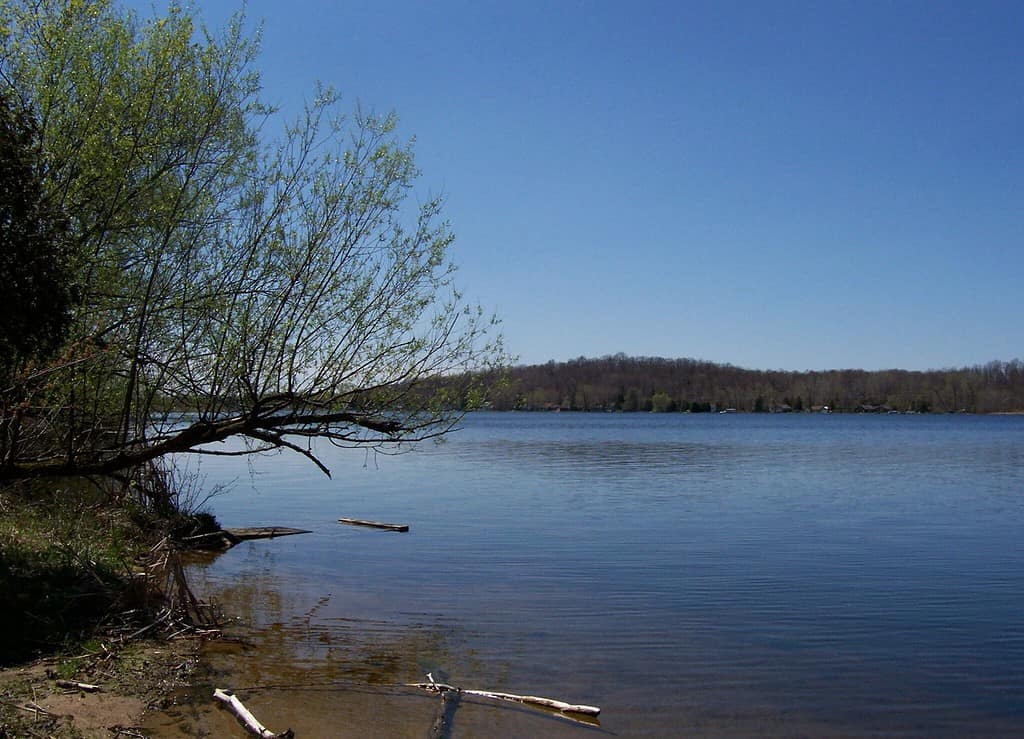
The lake also features a small pier and boat launching ramp.
Long Lake is a picturesque glacial lake in the Northern Kettle Moraine State Forest, part of the Ice Age Trail in Wisconsin. The Kettle Moraine State Forest is known for its unique glacial landscape, characterized by kettles, kames, and moraines left behind by the last ice age.
Scenic Beauty
Long Lake is popular for its natural beauty and tranquility. The lake is surrounded by rolling hills and dense forests, creating a serene and peaceful atmosphere. Tall pine trees and hardwoods provide a stunning backdrop to the lake’s clear waters.
Hiking
The Ice Age Trail passes by Long Lake, allowing hikers to enjoy its beauty as they trek along the trail. The specific distance from the start of the Ice Age Trail to Long Lake can vary depending on the trailhead you choose to start from, so it’s advisable to consult trail maps or local resources for exact distances.
Recreation
While visiting Long Lake, you can engage in various recreational activities, including hiking, birdwatching, and picnicking. Depending on local regulations and conditions, the lake area may also have opportunities for swimming or fishing.
Wildlife
Long Lake and the surrounding forests provide a habitat for various wildlife species. Watch out for birds, such as songbirds and waterfowl, as well as deer, squirrels, and other forest creatures.
Camping
Some state parks and forests in the Kettle Moraine region offer camping facilities. Hikers should plan ahead if willing to stay overnight for available campgrounds or backcountry camping options in the area.
Seasonal Changes
Long Lake’s beauty varies with the seasons. In the spring, you can enjoy the blossoming wildflowers, while summer offers the opportunity for water-based activities. Fall brings stunning foliage, making it a popular time for hiking, and winter provides opportunities for snowshoeing or cross-country skiing in the area.
5. Rice Lake
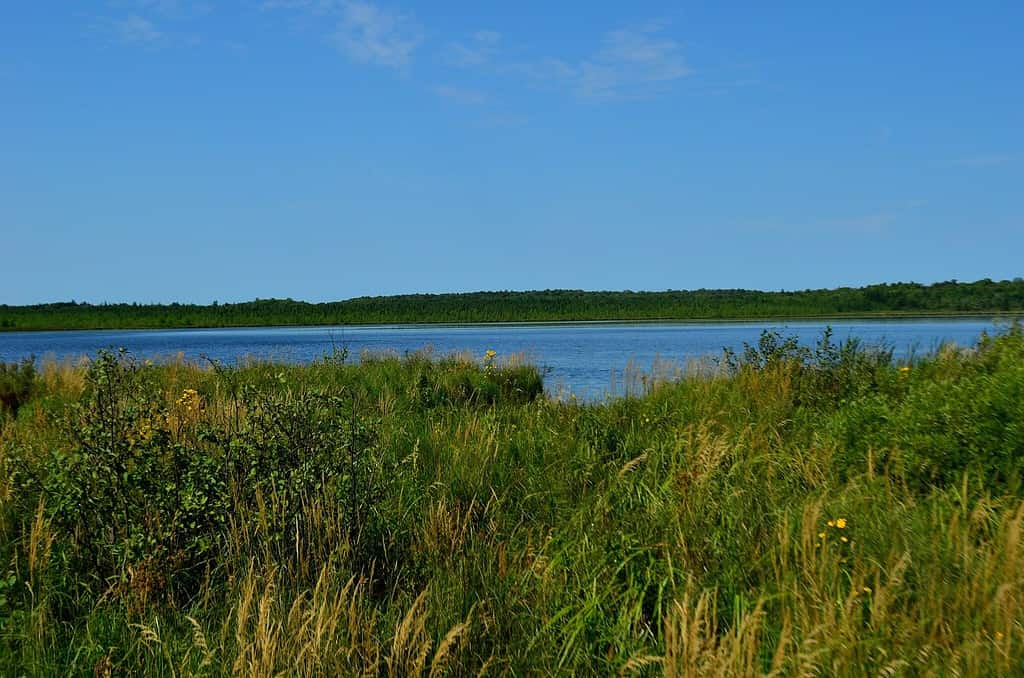
The lake shares its name with the neighboring city.
Rice Lake is a serene and scenic lake along the Ice Age Trail in Wisconsin’s Southern Kettle Moraine State Forest. This area has many glacially-formed landscapes, including kettles, moraines, and other geological features.
Scenic Beauty
Rice Lake is known for its natural beauty and tranquil atmosphere. The lake is surrounded by rolling hills covered in hardwood and coniferous forests, creating a picturesque setting. Its clear waters are inviting, making it a peaceful spot for hikers to rest and enjoy the scenery.
Hiking
The Ice Age Trail passes near Rice Lake, offering hikers the opportunity to appreciate its beauty as they traverse the trail. The specific distance from the start of the Ice Age Trail to Rice Lake can vary depending on which trailhead hikers begin their hike from. Hikers should consult trail maps or local resources for safety measures.
Recreation
While visiting Rice Lake, hikers can engage in various recreational activities, including hiking, picnicking, and birdwatching. The lake may also offer opportunities for fishing, but be sure to check on local regulations and conditions.
Wildlife
Rice Lake and the surrounding forests provide a habitat for various wildlife species. Keep an eye out for birds, such as songbirds and waterfowl, as well as deer, squirrels, and other forest creatures.
Camping
The Kettle Moraine State Forest offers camping facilities in various campgrounds. If you plan to stay overnight near Rice Lake, check if campgrounds or backcountry camping options are available in the area.
Seasonal Changes
Like many natural areas, Rice Lake’s beauty varies with the seasons. In spring, you can enjoy the blooming wildflowers, while summer offers opportunities for water-based activities. Fall brings stunning foliage, making it a popular time for hiking, and winter provides opportunities for snowshoeing or cross-country skiing in the area.
6. Mondeaux Flowage
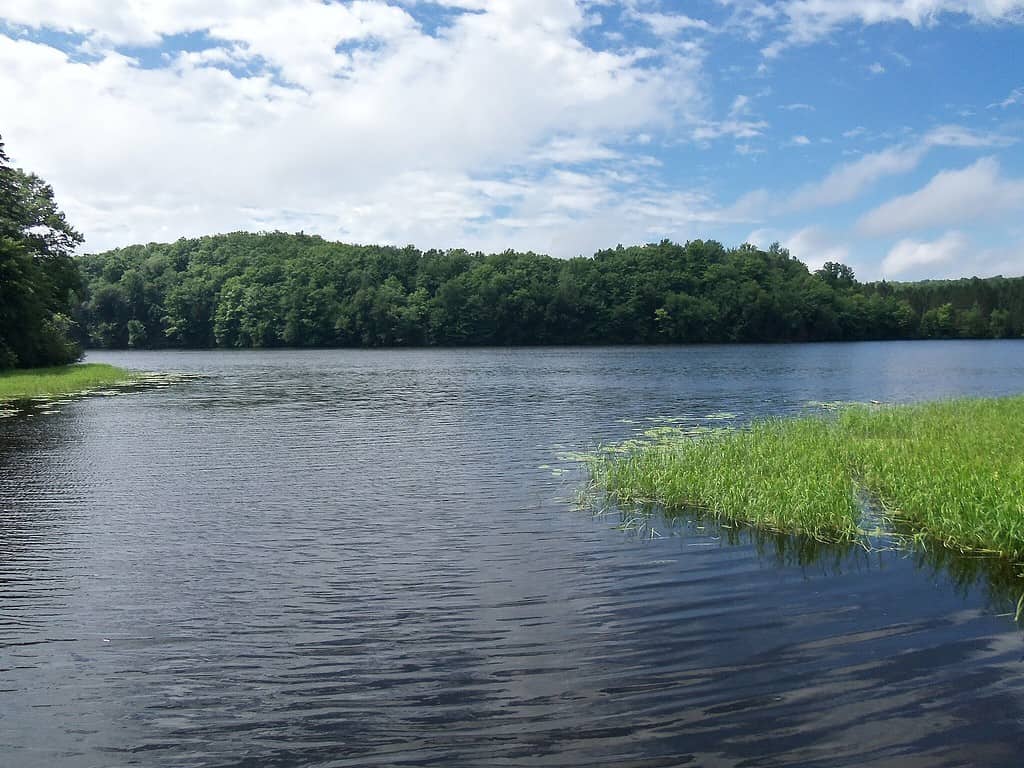
This lake features many islands that visitors are free to explore.
Mondeaux Flowage is a man-made reservoir created by the damming of the Mondeaux River. It is located in the Chequamegon-Nicolet National Forest in northern Wisconsin. It’s one of the many scenic spots you can encounter while hiking the Ice Age Trail in Wisconsin, specifically in the Ice Age Trail’s Timm’s Hill Segment.
The Mondeaux Flowage is approximately 10 miles east of the start of the Ice Age Trail at Interstate State Park, near St. Croix Falls. Interstate State Park is the western terminus of the Ice Age Trail.
Scenic Beauty
One of the highlights of visiting Mondeaux Flowage is the sheer natural beauty of the area. Forests surround this man-made reservoir, and the changing seasons offer different scenic vistas, making it a year-round destination for outdoor enjoyment.
Hiking
The Ice Age Trail offers a diverse range of terrain, and the Timm’s Hill Segment, in particular, features rolling hills, dense forests, and, of course, the Mondeaux Flowage. It’s a great place to take in the scenic beauty of northern Wisconsin.
In addition to the Ice Age Trail, which crosses near Mondeaux Flowage, there are other hiking trails in the area. These trails provide opportunities to explore the surrounding forested terrain and enjoy nature.
Recreation
Mondeaux Flowage offers boating opportunities and has a boat ramp for watercraft launch. Canoeing and kayaking are also popular, allowing visitors to paddle through the peaceful waters and explore the shoreline.
Mondeaux Flowage is a popular destination for anglers. The reservoir is famous for its excellent fishing opportunities, with various fish species, including panfish, bass, northern pike, and walleye. A fishing pier near the boat launch area makes it accessible for those without a boat.
Wildlife
The Chequamegon-Nicolet National Forest is home to diverse wildlife, including deer, bears, eagles, and various bird species. Wildlife enthusiasts will find plenty of opportunities to observe animals in their natural habitat.
Camping
Mondeaux Flowage has several campgrounds nearby, including the Mondeaux Dam Campground and Mondeaux Lodge Campground. These campgrounds offer tent and RV camping options for those looking to spend more time in the area.
Summary of the 6 Breathtaking Lakes Along Wisconsin’s Ice Age Trail
| Rank | Name | Counties |
|---|---|---|
| 1 | Lake Michigan | Brown, Door, Kenosha, Kewaunee, Manitowoc, Marinette, Milwaukee, Oconto, Ozaukee, Racine and Sheboygan |
| 2 | Devil’s Lake | Sauk |
| 3 | Lake Wisconsin | Columbia and Sauk |
| 4 | Long Lake | Fond du Lac |
| 5 | Rice Lake | Barron |
| 6 | Mondeaux Flowage | Taylor |
Thank you for reading! Have some feedback for us? Contact the AZ Animals editorial team.

